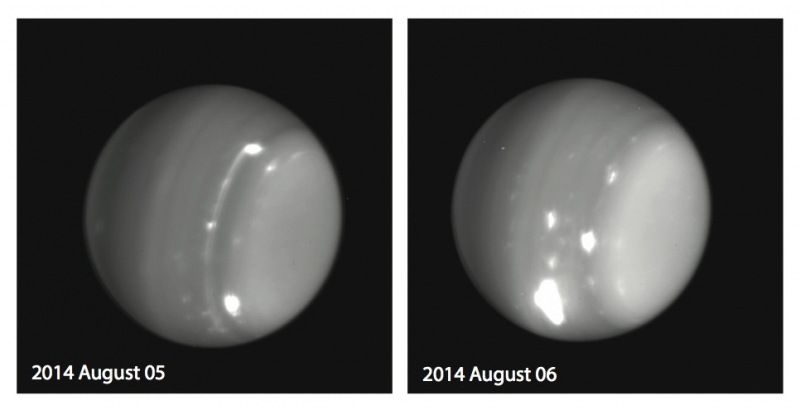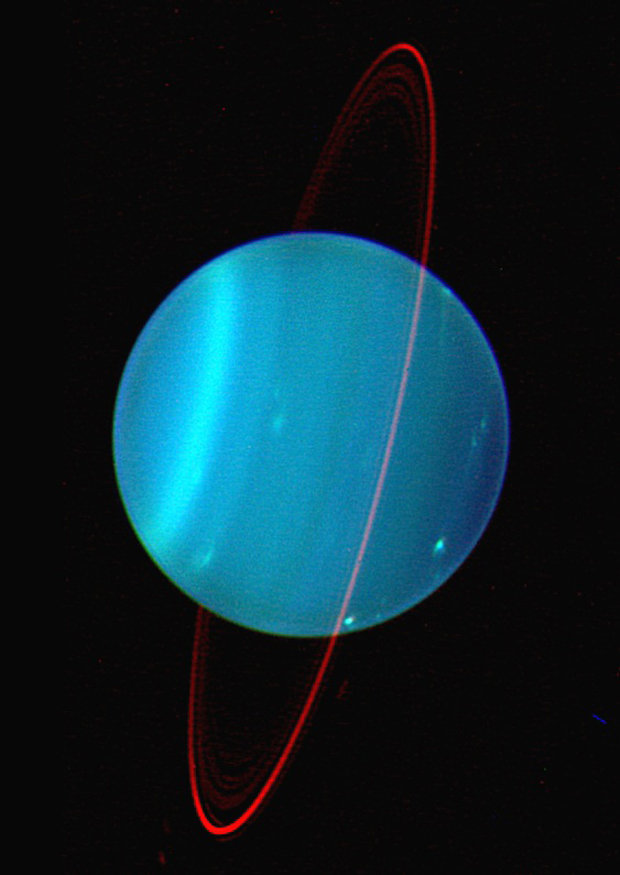Giant Storms Are Raging on Uranus (Photo)

A telescope on Earth has spotted huge storms brewing on the planet Uranus.
Scientists using the Keck Observatory in Hawaii have recently seen a number of storms develop on the planet. One image, taken on Aug. 5, shows a few bright spots in infrared photos taken of the planet. The bright bits show storms in the planet's atmosphere. A second photo of Uranus, taken on Aug. 6, reveals more bright spots.
One very large storm seen by the telescope has particularly interested researchers analyzing the views of Uranus. The storm reaches into the high altitudes of the planet's atmosphere, according to Keck representatives. [Photos: Biggest Storms in the Solar System]
"We are always anxious to see that first image of the night of any planet or satellite, as we never know what it might have in store for us," Imke de Pater, professor at UC Berkeley and team leader, said in a statement. "This extremely bright feature we saw on UT 6 August 2014 reminds me of a similarly bright storm we saw on Uranus’s southern hemisphere during the years leading up to and at equinox."
The new storm is reminiscent of a feature known as the "Berg," which disappeared in 2009, but could even have dated back to NASA's Voyager probe's flyby of the planet in 1986, according to Keck. The Berg — so named because the storm looked like an iceberg sloughing off an ice shelf — became very bright in 2004 and started to move toward the planet's equator in 2005.
Researchers will analyze data to measure exactly where it is located within the planet's atmosphere.
"Even after years of observing, a new picture of Uranus from Keck Observatory can stop me in my tracks and make me say Wow!" Heidi Hammel, a member of the observing team, said in the same statement.
Breaking space news, the latest updates on rocket launches, skywatching events and more!
Storms rage all across the solar system. At one point, Jupiter's Great Red Spot was once the size of three Earths, and a massive storm rages in Saturn's north pole.
Amateur astronomers on Earth can also spot Uranus in the night sky this month. The seventh planet from the sun rises in the late evening and can be seen in the constellation Pisces in the Northern Hemisphere.
Follow Miriam Kramer @mirikramer and Google+. Follow us @Spacedotcom, Facebook and Google+. Original article on Space.com.

Miriam Kramer joined Space.com as a Staff Writer in December 2012. Since then, she has floated in weightlessness on a zero-gravity flight, felt the pull of 4-Gs in a trainer aircraft and watched rockets soar into space from Florida and Virginia. She also served as Space.com's lead space entertainment reporter, and enjoys all aspects of space news, astronomy and commercial spaceflight. Miriam has also presented space stories during live interviews with Fox News and other TV and radio outlets. She originally hails from Knoxville, Tennessee where she and her family would take trips to dark spots on the outskirts of town to watch meteor showers every year. She loves to travel and one day hopes to see the northern lights in person. Miriam is currently a space reporter with Axios, writing the Axios Space newsletter. You can follow Miriam on Twitter.

